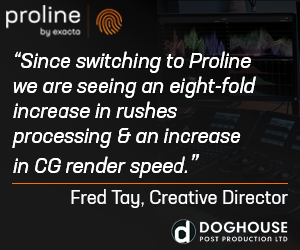Canon is launching two Super 35mm lenses for high-end 4K, 8K and HDR cinema productions, for its Flex Zoom line-up.
It is also expanding the functionality of its PTZ cameras with two new apps – Auto Tracking and Auto Loop – enabling users to add new functionalities for video production, alongside a firmware update.
The CN-E14-35mm T1.7 L S / SP and CN-E31.5-95mm T1.7 L S / SP are the fastest Super 35mm lenses on the market with such broad focal lengths[i]. The CN-E14-35mm T1.7 L, a wide angle 14-35mm zoom lens and the CN-E31.5-95mm T1.7 L, a mid-focal range lens with a 31.5-95mm zoom range.
For Canon’s Flex Zoom range, the CN-E14-35mm T1.7 L and CN-E31.5-95mm T1.7 L offer a fast constant aperture of T1.7 that creates a shallow depth of field, whilst also enhancing the compatibility with fast prime lenses when used together in the same production. Covering the most frequently used focal lengths in cinema production, these models offer high optical performance to create sharp, consistent images for 4K and 8K capture. Coupled with 11 Iris blades, this produces a bokeh effect and softly diffused light. Building on Canon’s heritage and colour science, the CN-E14-35mm T1.7 L and CN-E31.5-95mm T1.7 L achieve warm colours and true-to-life skin tone reproduction.
The CN-E14-35mm T1.7 L and CN-E31.5-95mm T1.7 L are flexible lenses, for a wide range of scenarios. There’s an interchangeable mount design that enables the lens to be switched between EF and PL mounts and these lenses are the first in Canon’s cinema range that make use of Canon’s interchangeable relay kit, enabling them to be switched from Super 35mm to Full Frame and back again, at any Canon authorised service centre[ii]. Weighing 3.3kg and 3.5kg respectively, the CN-E14-35mm T1.7 L and CN-E31.5-95mm T1.7 L have a compact, lightweight design.
Both lenses support efficient lens metadata workflows including Cooke /i Technology, and ZEISS eXtended Data via PL mount, alongside 4-pin Lemo connectivity. This works for virtual productions, where positional information is needed to ensure virtual backgrounds react as a natural background would to the perspective of the camera, as well as for post-production VFX workflows.
Canon is also announcing a collection of new firmware updates to further enhance and expand the capabilities of the EOS R5 C, EOS C70, EOS C300 Mark III and EOS C500 Mark II cameras. The update will bring a high resolution Clear Scan function, offering a more concise range from 50 to 250Hz, providing greater synchronisation support when shooting LED screens on virtual productions. In addition, an option to change the in-camera waveform monitor size, as well as further metadata support for the latest Canon lenses, has been added.
The two new apps for its PTZ cameras were first announced in January, and showcased at ISE 2023 with the CR-N700. Canon’s Auto Tracking Application RA-AT001 and the Auto Loop Application RA-AL001 – can be used with the CR-N500, CR-N300 and CR-X300 from August.
Both apps build on market demand to create a powerful standalone solution for video production without the need for external hardware.
Powered by Canon’s advanced drive mechanism in its PTZ cameras, the new Auto Tracking application automatically tracks people with precision, to ensure they are always framed and in-shot, without the intervention of a camera operator.
With the new firmware, the Auto Tracking application becomes compatible with a wider range of PTZ models – the CR-N500 and CR-N300.
The Auto Loop application is being made available for the CR-N500, CR-N300 and CR-X300, enabling the cameras to follow a pre-programmed, automated pan/tilt/zoom movement without the need for an operator to manually change the shot.
The Auto Tracking and Auto Loop applications are currently available for the CR-N700 and will be available for other PTZ models with the firmware update later in 2023.
Canon’s latest firmware update enhances user experience and workflow – whether the camera is being used independently, or part of a multi-camera set-up. When used in conjunction with Cinema EOS cameras or Canon’s XA / XF series camcorders, the CR-N500, CR-N300 and CR-X300 can tap into common settings – including the capability of setting the shutter angle in addition to the shutter speed. It’s also easier to match the image from other cameras than before, with added colour compensation function for white balance. The CR-X300 will have the addition of SRT protocol and Free-D protocol support, enabling easier workflow integration – particularly in live events and sports.
Pippa Considine
Share this story

















